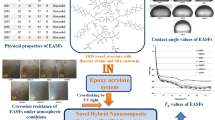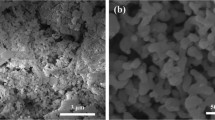Abstract
In the era of sustainability, direct-to-metal coatings have proven to be a promising solution as it eliminates the need for underneath primer coating layers. In the present study, two coating systems, viz. acrylic polyurethane and acrylic-polyester hybrid polyurethane nano-composite coatings, were prepared by addition of nano-silica in various loadings for direct-to-metal coating applications. The addition of nano-silica along with selected resin systems enables to meet desired mechanical properties, chemical resistance along with weathering and corrosion resistance of DTM coating system. Incredible improvement in the overall mechanical properties of the coating including pencil hardness and scratch resistance has been observed by the addition of nano-silica. SEM technique was employed to evaluate the nano-silica dispersion into the coating system along with its morphology. SEM studies revealed thorough dispersion of the nanoparticles within the coating matrix for both the coating systems. Thermal properties were studied by thermogravimetric analysis along with structural characterization by Fourier transform infrared spectroscopy. Thermal stability of both the coating systems increased with the addition of nano-silica; however, acrylic-polyester hybrid polyurethane coatings revealed better thermal stability at 8% nano-silica loading. Color and gloss changes were studied before and after 500 h exposure to a QUV chamber. Anticorrosive properties were evaluated by salt spray exposure for 700 h. At 8% nano-silica loading, acrylic-polyester hybrid polyurethane coatings revealed better weathering performance along with anticorrosive properties and chemical resistance owing to the presence of hybrid polymer chains.














Similar content being viewed by others
References
Santos, D, Brites, C, Costa, MR, Santos, MT, “Performance of paint systems with polyurethane topcoats, proposed for atmospheres with very high corrosivity category.” Prog. Org. Coat., 54 (4) 344–352 (2005)
Potter, TA, Kahl, L, “1K and 2K polyurethanes for automotive topcoats.” SAE Techn. Papers, 412 7–12 (1993)
Kralj, M, Pavković, K, Stojanović, I, Anđal, J, “Adhesion and anticorrosive properties of DTM coating as related to primer coating.” Gradjevinar, 71 (5) 401–408 (2019)
Clamen, G, et al. “Protection of metal with a novel waterborne acrylic/urethane hybrid technology.” Prog. Org. Coat., 72 (1–2) 144–151 (2011)
Bulick AS, LeFever CR, Frazee GR, Jin K, Mellott ML, “Metal adhesion and corrosion resistance in waterborne, styrenated acrylic direct to metal (DTM) resins,” Eur. Coat. Show, 2017(1) (2017)
Gao, T, He, Z, Hihara, LH, Mehr, HS, Soucek, MD, “Outdoor exposure and accelerated weathering of polyurethane/polysiloxane hybrid coatings.” Prog. Org. Coat., 130 44–57 (2019)
Gite, VV, Mahulikar, PP, Hundiwale, DG, “Preparation and properties of polyurethane coatings based on acrylic polyols and trimer of isophorone diisocyanate.” Prog. Org. Coat., 68 (4) 307–312 (2010)
Gite, VV, Mahulikar, PP, Hundiwale, DG, Kapadi, UR, “Polyurethane coatings using trimer of isophorone diisocyanate.” J. Sci. Industr. Res., 63 (4) 348–354 (2004)
Kabra, AP, Mahanwar, P, Shertukde, V, Bambole, V, “Performance of nanosilica in acrylic polyol 2K polyurethane coatings.” Pigment Resin Technol., 41 (4) 230–239 (2012)
Zhang, J, Tu, W, Dai, Z, “Transparent polyester polyol-based polyurethane coatings: the effect of alcohols.” J. Coat. Technol. Res., 10 (6) 887–895 (2013)
Zhang, J, Tu, W, Dai, Z, “Synthesis and characterization of transparent and high impact resistance polyurethane coatings based on polyester polyols and isocyanate trimers.” Prog. Org. Coat., 75 (4) 579–583 (2012)
Chen, X, Wu, L, Zhou, S, You, B, “In situ polymerization and characterization of polyester-based polyurethane/nano-silica composites.” Polymer Int., 52 (6) 993–998 (2003)
Baer, DR, Burrows, PE, El-Azab, AA, “Enhancing coating functionality using nanoscience and nanotechnology.” Prog. Org. Coat., 47 (3–4) 342–356 (2003)
Presting, H, König, U, “Future nanotechnology developments for automotive applications.” Mater. Sci. Eng. C, 23 (6–8) 737–741 (2003)
Gläsel, HJ, et al. “Preparation of scratch and abrasion resistant polymeric nanocomposites by monomer grafting onto nanoparticles, 2a: Characterization of radiation-cured polymeric nanocomposites.” Macromol. Chem. Phys., 201 (18) 2765–2770 (2000)
Maganty, S, et al. “Enhanced mechanical properties of polyurethane composite coatings through nanosilica addition.” Prog. Org. Coat., 90 243–251 (2016)
Syamsundar, C, Chatterjee, D, Kamaraj, M, Maiti, AK, “Erosion characteristics of nanoparticle-reinforced polyurethane coatings on stainless steel substrate.” J. Mater. Eng. Perform., 24 (4) 1391–1405 (2015)
Rashvand, M, Ranjbar, Z, Rastegar, S, “Nano zinc oxide as a UV-stabilizer for aromatic polyurethane coatings.” Prog. Org. Coat., 71 (4) 362–368 (2011)
Mondal, C, et al. “Deposition of zinc oxide nanomaterial on different substrates for useful applications.” Cryst. Eng. Comm., 16 (20) 4322–4328 (2014)
Rashvand, M, Ranjbar, Z, “Effect of nano-ZnO particles on the corrosion resistance of polyurethane-based waterborne coatings immersed in sodium chloride solution via EIS technique.” Prog. Org. Coat., 76 (10) 1413–1417 (2013)
Fangli, Y, Peng, H, Chunlei, Y, Shulan, H, Jinlin, L, “Preparation and properties of zinc oxide nanoparticles coated with zinc aluminate.” J. Mater. Chem., 13 (3) 634–637 (2003)
Lowry, MS, Hubble, DR, Wressell, AL, Vratsanos, MS, Pepe, FR, Hegedus, CR, “Assessment of UV-permeability in nano-ZnO filled coatings via high throughput experimentation.” J. Coat. Technol. Res., 5 (2) 233–239 (2008)
Shi, H, Liu, F, Yang, L, Han, E, “Characterization of protective performance of epoxy reinforced with nanometer-sized TiO2 and SiO2.” Prog. Org. Coat., 62 (4) 359–368 (2008)
Allen, NS, Edge, M, Ortega, A, Liauw, CM, Stratton, J, McIntyre, RB, “Behaviour of nanoparticle (ultrafine) titanium dioxide pigments and stabilisers on the photooxidative stability of water based acrylic and isocyanate based acrylic coatings.” Polymer Degrad. Stability, 78 (3) 467–478 (2002)
Allen, NS, et al. “Degradation and stabilisation of polymers and coatings: nano vs pigmentary titania particles.” Polymer Degrad. Stability, 85 (3) 927–946 (2004)
Chen, XD, Wang, Z, Liao, ZF, Mai, YL, Zhang, MQ, “Roles of anatase and rutile TiO2 nanoparticles in photo oxidation of polyurethane.” Polymer Test., 26 (2) 202–208 (2007)
Shi, X, Nguyen, TA, Suo, Z, Liu, Y, Avci, R, “Effect of nanoparticles on the anticorrosion and mechanical properties of epoxy coating.” Surf. Coat. Technol., 204 (3) 237–245 (2009)
Groenewolt, M, “Highly scratch resistant coatings for automotive applications.” Prog. Org. Coat., 61 (2–4) 106–109 (2008)
Seubert, C, Nietering, K, Nichols, M, Wykoff, R, Bollin, S, “An overview of the scratch resistance of automotive coatings: exterior clearcoats and polycarbonate hardcoats.” Coatings, 2 (4) 221–234 (2012)
Bertrand-Lambotte, P, Loubet, JL, Verpy, C, Pavan, S, “Understanding of automotive clearcoats scratch resistance.” Thin Solid Films, 420–421 281–286 (2002)
Latthe, SS, et al. “Self – cleaning superhydrophobic coatings: potential industrial applications.” Prog. Org. Coat., 128 52–58 (2019)
Tahmassebi, N, Moradian, S, Ramezanzadeh, B, Khosravi, A, Behdad, S, “Effect of addition of hydrophobic nano silica on viscoelastic properties and scratch resistance of an acrylic/melamine automotive clearcoat.” Tribol. Int., 43 (3) 685–693 (2010)
Barna, E, et al. “Innovative, scratch proof nanocomposites for clear coatings.” Comp. Part A: Appl. Sci. Manuf., 36 (4) 473–480 (2005)
Scrinzi, E, Rossi, S, Kamarchik, P, Deflorian, F, “Evaluation of durability of nano-silica containing clear coats for automotive applications.” Prog. Org. Coat., 71 (4) 384–390 (2011)
Chen, Y, Zhou, S, Yang, H, Gu, G, Wu, L, “Preparation and characterization of nanocomposite polyurethane.” J. Colloid Interface Sci., 279 (2) 370–378 (2004)
Zhou, S, Wu, L, Sun, J, Shen, W, “The change of the properties of acrylic-based polyurethane via addition of nano-silica.” Prog. Org. Coat., 45 (1) 33–42 (2002)
Dashtizadeh, A, Abdouss, M, Mahdavi, H, Khorassani, M, “Acrylic coatings exhibiting improved hardness, solvent resistance and glossiness by using silica nano-composites.” Appl. Surf. Sci., 257 (6) 2118–2125 (2011)
Chen, G, Zhou, S, Gu, G, Yang, H, Wu, L, “Effects of surface properties of colloidal silica particles on redispersibility and properties of acrylic-based polyurethane/silica composites.” J. Colloid Interface Sci., 281 (2) 339–350 (2005)
Zhou, S, Wu, L, Xiong, M, He, Q, Chen, G, “Dispersion and UV-VIS properties of nanoparticles in coatings.” J. Dispersion Sci. Technol., 25 (4) 417–433 (2004)
Chen, G, Zhou, S, Gu, G, Wu, L, “Modification of colloidal silica on the mechanical properties of acrylic based polyurethane/silica composites.” Coll. Surf. A: Physicochem. Eng. Aspects, 296 (1–3) 29–36 (2007)
Allahverdi, A, Ehsani, M, Janpour, H, Ahmadi, S, “The effect of nanosilica on mechanical, thermal and morphological properties of epoxy coating.” Prog. Org. Coat., 75 (4) 543–548 (2012)
Mirabedini, SM, Sabzi, M, Zohuriaan-Mehr, J, Atai, M, Behzadnasab, M, “Weathering performance of the polyurethane nanocomposite coatings containing silane treated TiO2 nanoparticles.” Appl. Surf. Sci., 257 (9) 4196–4203 (2011)
Chen, Y, Zhou, S, Yang, H, Wu, L, “Structure and properties of polyurethane/nanosilica composites.” J. Appl. Polymer Sci., 95 (5) 1032–1039 (2005)
Carneiro, C, Vieira, R, Mendes, AM, Magalhães, FD, “Nanocomposite acrylic paint with self-cleaning action.” J. Coat. Technol. Res., 9 (6) 687–693 (2012)
Malaki, M, Hashemzadeh, Y, Fadaei Tehrani, A, “Abrasion resistance of acrylic polyurethane coatings reinforced by nano-silica.” Prog. Org. Coat., 125 507–515 (2018)
Malaki, M, Hashemzadeh, Y, Karevan, M, “Effect of nano-silica on the mechanical properties of acrylic polyurethane coatings.” Prog. Org. Coat., 101 477–485 (2016)
Li, X, Cao, Z, Zhang, Z, Dang, H, “Surface-modification in situ of nano-SiO2 and its structure and tribological properties.” Appl. Surf. Sci., 252 (22) 7856–7861 (2006)
Bertrand-Lambotte, P, Loubet, JL, Verpy, C, “Mar and scratch resistance of automotive clearcoats: development of new testing methods to improve coatings.” Tribol. Ser., 39 883–893 (2001)
Shen, W, et al. “A quantitative index for mar and scratch resistance of materials for automotive glazing applications and quantitative evaluation of damages by different scratching modes.” Tribol. Lett., 17 (3) 637–644 (2004)
Madireddi, N, Mahanwar, PA, “Anticorrosive polyurethane clear coat with self-cleaning character.” Int. J. Chem, Molec, Nucl, Mater. Metall. Eng., 10 (1) 34–41 (2016)
Bui, TMA, et al. “Investigation of crosslinking, mechanical properties and weathering stability of acrylic polyurethane coating reinforced by SiO2 nanoparticles issued from rice husk ash.” Mater. Chem. Phys., 241 122445 (2020)
Mills, DJ, Jamali, SS, Paprocka, K, “Investigation into the effect of nano-silica on the protective properties of polyurethane coatings.” Surf. Coat. Technol., 209 137–142 (2012)
Jalili, MM, Moradian, S, Dastmalchian, H, Karbasi, A, “Investigating the variations in properties of 2-pack polyurethane clear coat through separate incorporation of hydrophilic and hydrophobic nano-silica.” Prog. Org. Coat., 59 (1) 81–87 (2007)
Ni, L, et al. “Direct-to-metal UV-cured hybrid coating for the corrosion protection of aircraft aluminium alloy.” Corros. Sci., 89 242–249 (2014)
Jalili, MM, Moradian, S, “Deterministic performance parameters for an automotive polyurethane clearcoat loaded with hydrophilic or hydrophobic nano-silica.” Prog. Org. Coat., 66 (4) 359–366 (2009)
Gaumet, BPS, Lemaire, J, “Influence of titanium dioxide pigment characteristics on durability of four paints (acrylic isocyanate, polyester melamine, polyester lsocyanate, alkyd).” Surf. Coat. Int., 8 367–372 (1997)
Author information
Authors and Affiliations
Corresponding author
Additional information
Publisher's Note
Springer Nature remains neutral with regard to jurisdictional claims in published maps and institutional affiliations.
Rights and permissions
About this article
Cite this article
Gangopadhyay, S., Mahanwar, P.A. Nano-silica-containing acrylic polyurethane and acrylic-polyester hybrid polyurethane coatings for direct-to-metal (DTM) coating applications – a comparative study. J Coat Technol Res 19, 1773–1786 (2022). https://doi.org/10.1007/s11998-022-00647-5
Received:
Revised:
Accepted:
Published:
Issue Date:
DOI: https://doi.org/10.1007/s11998-022-00647-5




